(or lack of them!) at St Mary's and St Faith's.
Sam, as he will be the first to admit, is a campanological fanatic, and this developing feature will bring news and reports of his investigations at St Mary's and his plans for St Faith's. We begin with the first part of his account of what he and some friends got up to in unexplored corners (and heights) of St Mary's. Appropriately enough, he entitles his account...
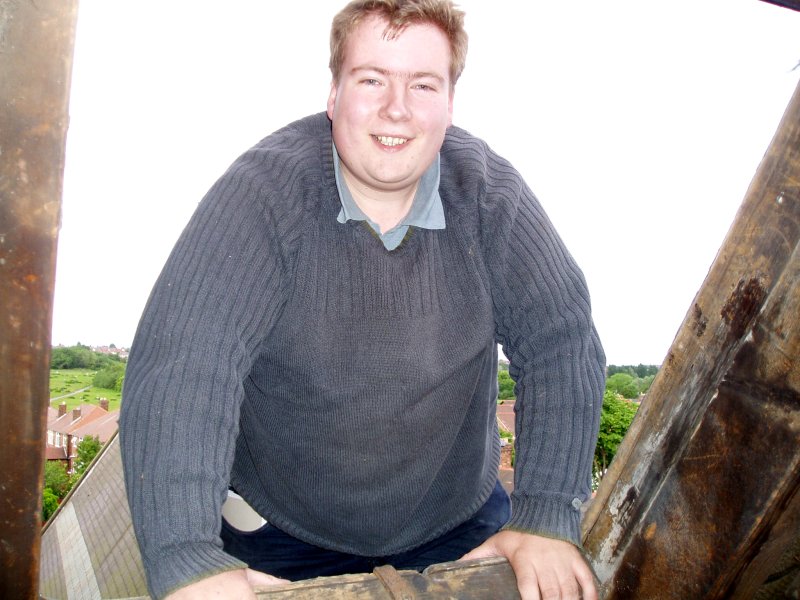
The author descending
from the transept roof. This photograph was going
to be used in the obituary in the case of him falling off.
To the dear memory of
MARY STANLEY
and in gratitude to God for her beautiful life
of unselfish service and devoted companionship
THE * BELLS * OF * THIS * CHURCH
were given by her loving husband
ERNEST * F * STANLEY
and were dedicated to the Praise and Glory of God
on New Years Eve, December 31st 1914.
AMAVIMUS * AMAMUS * AMABINUS
Evidence from the Parish Magazine and from the manufacturers catalogue showed that it was not a change ringing peal installed in the tower, but a chime of tubular bells, probably eight in number.
Where they still up there? Could they be brought back into use?
During the summer of 2010, a group of four interested campanological enthusiasts ascended the tower to discover what was contained within.
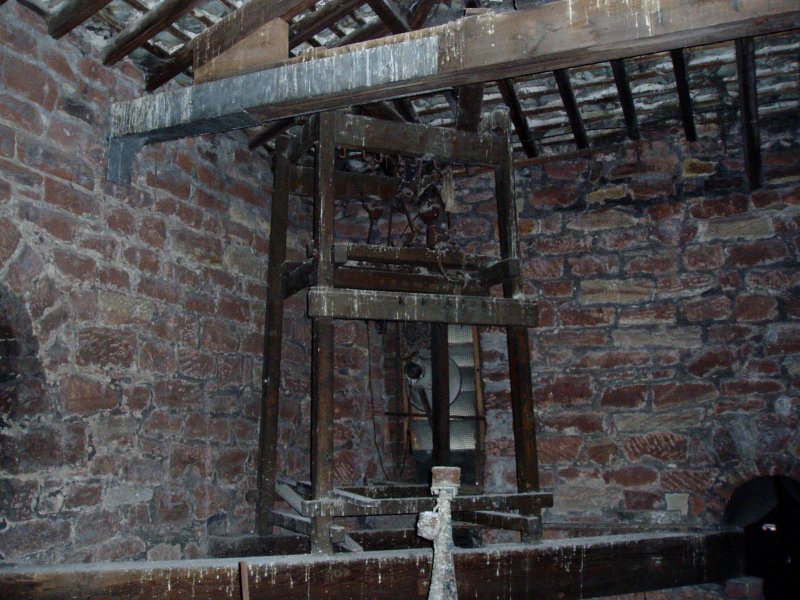
The empty bell frame in the
north west corner of the tower
The climb was not straight forward, and certainly shows the architect's lack of thought when it came to access!
First, we climbed a ladder from ground level on to the flat vestry roof, following that we climbed a second ladder from the vestry roof onto the edge of the pitched transept roof. Once we were at the summit of that second ladder, we took a leap of faith on to another ladder, 'fixed' to the transept roof. At the top of the transept roof ladder, there is a small trapdoor leading into the roof space of the South Transept. We crawled along the roof space and into the tower itself, whilst admiring the view of the church below through the holes in the floor. Further on, we reached the large internal space of the tower, and we were able to stand up quite comfortably.
By torchlight, we found the frame and the remains of the mechanisms for sounding the tubes looking forlorn in the North West corner of the tower, but alas, no bells. The frame had space and fastenings for eight tubular bells, but further detective work found that there had only ever been five bells installed. We then began gazing at the ceiling of the chancel crossing, but this time from the opposite side, looking for holes through which the ropes would have descended from the bell hammers, and penetrated the floor that led into the church. There were none.
In the opposite corner of the tower, there is a row of five fixed pulleys which indicated the rather curious arrangement, described as follows:
The bell ropes were drawn across the tower from the bell hammers and engaged with pulleys that guided the ropes down a tube which exited onto the vestry roof. On the vestry roof, there is evidence that there had previously been a manual for sounding the bells, encased in some kind of a shed.
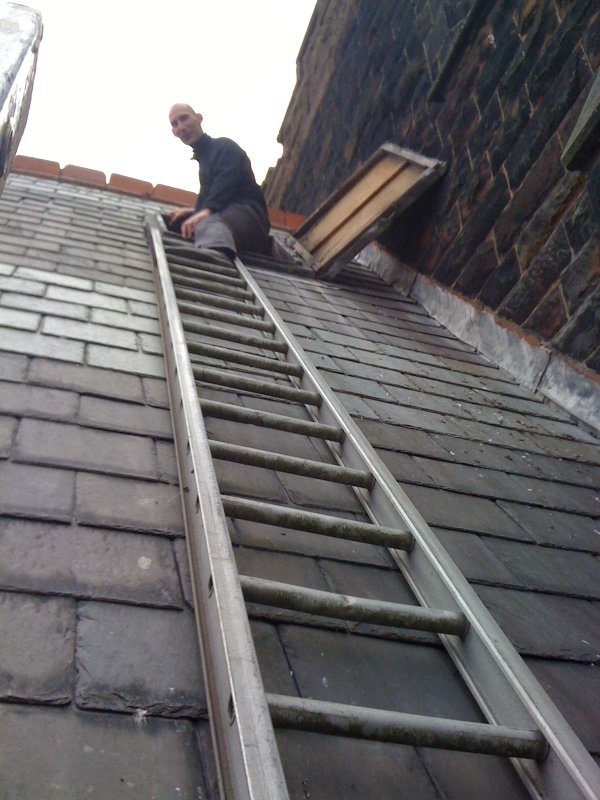
John
Greenhough
demonstrates the trapdoor in the transept roof
Bizarrely, this means that the bell ringer would have had to climb on to the vestry roof to sound the bells! Owing to the unusual set-up of this installation, it could never have been satisfactory to use, and it is therefore no surprise that the bells fell into disuse and were removed.
Before braving the descent, we found one more item of interest. In the South East corner of the tower, and above the five pulleys, there are two beams which show evidence of being used to hang a traditional bell, along with an associated pulley. Judging from the size and spacing of the beams, this bell could have been no bigger than 56lbs.
The incumbent at St. Mary's from 1898-1939, Revd. S. J. Sykes, writes about the bells in the parish magazine during this period:
"I have also very great pleasure in recording here that Mr. E. F. Stanley has expressed his wish to put £100 at the disposal of the Vicar and Churchwardens for a New Bell.....It will require some thought and enquiry before we can decide exactly on the bell best suited to our purpose.
(Parish Notes December 1914)
The New Bells
Before you read this letter you will have heard (I hope on Christmas morning) the new bells which Mr. E. F. Stanley has offered for a memorial gift. I hope that the choice of tubular chimes will commend itself to all who hear them. For various reasons they seem fitted by quality of tone for a Church placed as ours is, and their purpose guaranteed quite sufficient for our purpose. This morning I listened to the last strokes of the old bell after its thirty-five years of service. I could not forget the coincidence that its final silence in our Church fell on the anniversary of the death of my predecessor, the late Rev. Henry Burrowes, the first Incumbent of St. Mary's, who passed away on St. Thomas' Day seventeen years ago. We hope to dedicate the new bells on New Year's Eve.
(Parish Notes January 1915)
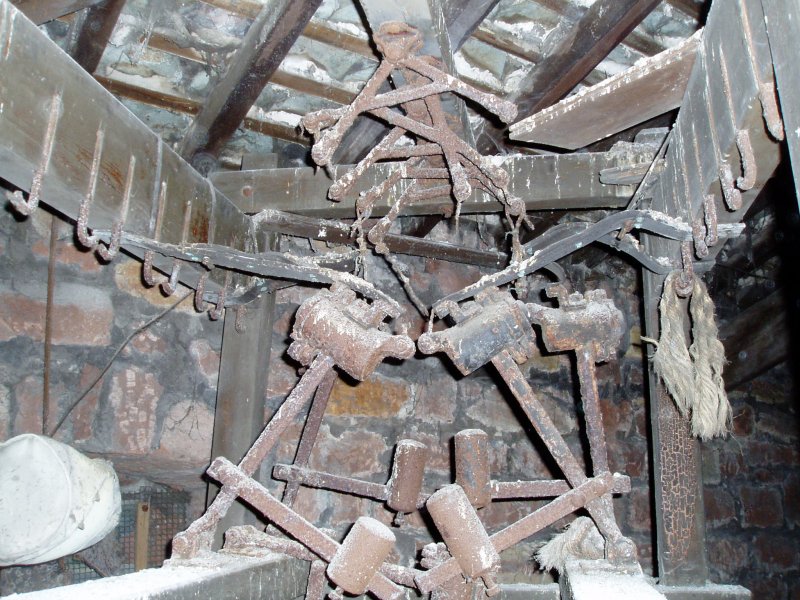
The
remains
of the mechanism and hammers used for striking the bells
The Bells
At a brief but, I think impressive Service on New Year's Eve, the new bells were dedicated. There was noticed at first some defect in the chime, since one bell was a little out of tune with the others. This has now been remedied. Another matter is not so easy to deal with. I refer to the slight thud heard in the Church when the hammers strike the bells. The cause is that the frame holding the tubes stands upon a wooden floor. I am informed that if the floor were of concrete or stone no such sound would be heard, but that it is unavoidable when the frame rests upon wood or lead. A tablet recording the gift and the occasion of it has been put up on the South Aisle wall.
(Parish Notes February 1915)
The old bell which served for our Iron Church and for the existing building during 35 years has now been given to the church of St. Paul, Goose Green, near Wigan, so that although we have no more use for it, its usefulness, let us hope, is by no means at an end. "
(Parish Notes June 1915)
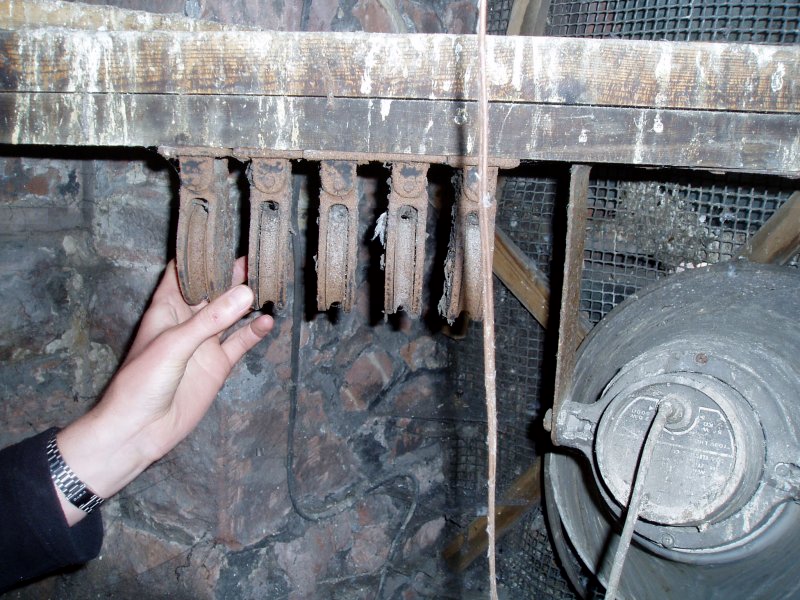
. The row of five pulleys
No trace of the original St. Mary's bell can be found, presumably it
was broken up and used in the casting of a brand new clock chime,
installed at St. Paul's church in 1934. Conclusion
In relatively recent times, St Mary's installed an electric church bell system with large conical speakers placed in the belfry. One bell cassette regularly used is called “Sounds of the City”, and contains recordings of London bells the author has rung and knows very well, including: St Mary le Bow, St Vedast Foster Lane, St Lawrence Jewry, St Olave Hart Street and rather poignantly, St Michael's Cornhill whose ancient bells are about to be broken up and replaced with a modern ring. Maybe one day, real bells will peal forth from the tower of St. Mary's....
Sam Austin
Thanks must be made to the following:
The vicar and churchwardens of St. Mary's for allowing us to ascend the tower.
John Greenhough,
Bryan McCahey (who acted as photographer)
Raymond Woods (who provided the ladders courtesy of Southport Hire Centre)
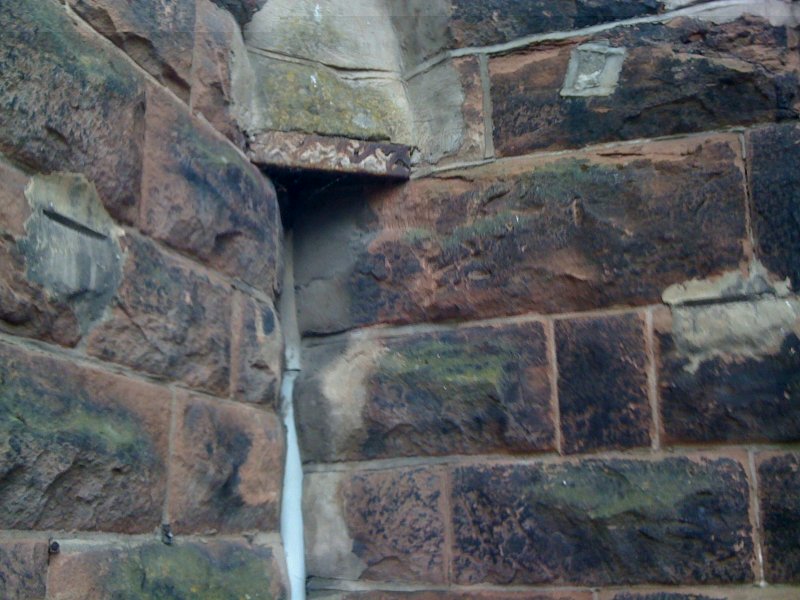
The
location
of the ringing apparatus on the vestry roof, showing the end
of the tube
Coming soon: the plans for bells at St Faith's!
Return to the home page
Coming soon: the plans for bells at St Faith's!
Return to the home page